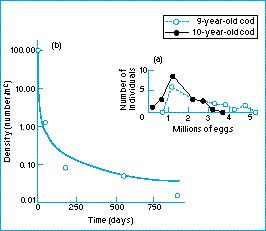Natural selection and variation - What is the struggle for existence?

Why aren't the oceans overrun by Atlantic cod?
The Atlantic cod (Gadus callarias ) is one of the most fecund of vertebrates. Female cod lay their eggs on the surface of the water; as soon as they are discharged, a slaughter begins, as can be seen in the graph opposite. A negligible proportion of the 5 million or so eggs laid by a female cod in her lifetime will survive and reproduce: an average female in the cod population will produce only two successful offspring.
This figure, that on average two eggs per female survive to reproduce successfully, is not the result of an observation: it comes from a logical calculation. Only two can survive, because any other number would be unsustainable over the long term. It takes a pair of individuals to reproduce. If an average pair in a population produce less than two offspring, the population will soon go extinct; if they produce more than two on average, the population will rapidly reach infinity - which is also unsustainable. So if two is the optimum number of offspring to maintain the population, why do females produce the other 4,999,998 eggs?
Figure: mortality of cod in their first two years of life. From Cushing (1975).
| Next |



